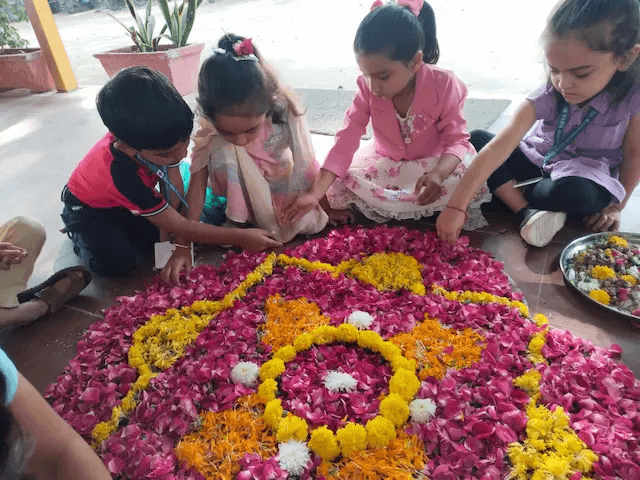From Robotics to Rangoli: Rethinking Extracurricular Activities for Students in Indian Schools
In India’s fast-evolving education landscape, schools are no longer confined to books and blackboards. From building robots to creating rangolis, extracurricular activities for students are becoming more dynamic, inclusive, and essential than ever.
SSRVM (Sri Sri Ravishankar Vidya Mandir) stands out by blending tradition with innovation. Unlike other institutions that focus solely on academics or competitive sports, SSRVM integrates a broader vision where Extracurricular Activities for Kids support holistic development, cultural appreciation, and future-readiness.
Let’s break down how Indian schools can rethink their extracurricular programs for maximum impact and why SSRVM is leading this shift.
Why Rethink Extracurricular Activities?
Modern students face more pressure than any previous generation academic stress, digital overload, and an increasingly competitive world. To thrive, they need more than just good grades.
Here’s what well-rounded extracurricular programs provide:
Cognitive flexibility through STEM projects
Emotional resilience via mindfulness and arts
Cultural connection with traditional Indian crafts
21st-century skills like coding, collaboration, and creative thinking
The Changing Face of Extracurricular Activities in Indian Schools
1. Rise of STEM Education in India
STEM (Science, Technology, Engineering, and Mathematics) is no longer optional. It’s fundamental.
Robotics clubs, coding bootcamps, 3D printing, and AI labs are becoming common in progressive schools.
STEM Education in India develops problem-solving, analytical thinking, and curiosity.
SSRVM integrates STEM learning with real-world applications like eco-projects, tech exhibitions, and innovation fairs.
Tip: Using STEM to enhance Extracurricular Activities for Students makes the programs relevant to modern careers.
2. Celebrating India’s Artistic Roots
While STEM builds the mind, the arts nurture the soul.
Rangoli-making, classical dance, pottery, and folk music are not just hobbies, they're heritage.
These activities promote mindfulness, creativity, and cultural identity.
SSRVM ensures every child is exposed to Indian traditional arts, often neglected in mainstream curriculums.
Why it matters: When kids learn to draw a kolam or perform a classical dance, they connect deeply with Indian ethos.
3. Digital Fluency as a Life Skill
With AI, blockchain, and social media transforming industries, digital literacy is crucial.
Schools are integrating video editing, podcasting, UI/UX design, and ethical social media use as extracurricular options.
SSRVM encourages tech-savvy creativity without losing sight of values and mental well-being.
Future-focused: These programs equip students to create not just consume technology.
4. Mindfulness, Nature, and Service
Education should shape character. Activities that connect students to themselves, society, and the planet are vital.
Yoga, gardening, volunteering, and meditation are core at SSRVM.
These cultivate empathy, discipline, and ecological awareness skills often missing in traditional education.
What Sets SSRVM Apart?
Here’s how SSRVM's approach to Extracurricular Activities for Kids and teens stands out:
Integrated Curriculum: Activities are not “add-ons” but woven into daily learning.
Balance of Modern and Traditional: Equal weight to robotics and rangoli, coding and classical music.
Holistic Development Focus: Emotional, intellectual, physical, and spiritual growth.
Teacher Mentorship: Trained educators guide each student’s unique interests.
Cultural Depth: Festivals, ancient art forms, and Indian heritage are celebrated and taught, not sidelined.
Sample List of Innovative Extracurricular Activities for Students
✅ Robotics & Coding Clubs
✅ Bharatanatyam, Kathak & Carnatic Vocal
✅ Gardening & Environmental Science Projects
✅ Rangoli, Warli & Madhubani Art Workshops
✅ Podcasting & Video Editing Studios
✅ Public Speaking & Debating Societies
✅ Yoga, Meditation & Mindfulness Sessions
✅ Community Service & Volunteering Drives
✅ Sanskrit Chanting & Vedic Science Exploration
✅ STEM Challenges and Innovation Fairs
How to Choose the Right Mix of Activities?
Parents and educators should aim for variety and balance. Here are a few pointers:
Include at least one STEM and one creative/artistic activity
Rotate new activities each term to expose students to diverse skills
Allow student-led projects to build leadership and initiative
Watch for signs of burnout; extracurriculars should energize, not exhaust
FAQs
Q1. Why are extracurricular activities important for students in India today?
A1. They help students build life skills, reduce academic stress, and develop a holistic personality beyond textbooks.
Q2. How is SSRVM different in its approach?
A2. SSRVM balances modern skills like STEM with traditional Indian values, arts, and mindfulness practices.
Q3. What are the best extracurricular activities for kids interested in technology?
A3. Robotics, coding, 3D design, AI projects, and app development are excellent choices.
Q4. Are traditional arts still relevant today?
A4. Absolutely. They build patience, discipline, cultural identity, and are proven to boost emotional well-being.
Q5. How many activities should a student ideally pursue?
A5. 2–3 well-balanced activities per term are ideal spanning tech, art, physical movement, or service.
Conclusion
In the 21st century, learning isn’t limited to the classroom. From STEM education in India to age-old traditions like rangoli-making, a strong extracurricular program builds more than just resumes it shapes character.
SSRVM offers a model that others can follow: one that nurtures creativity, cultural grounding, and future-readiness all in one. As parents and educators, it’s time we rethink what learning looks like.

